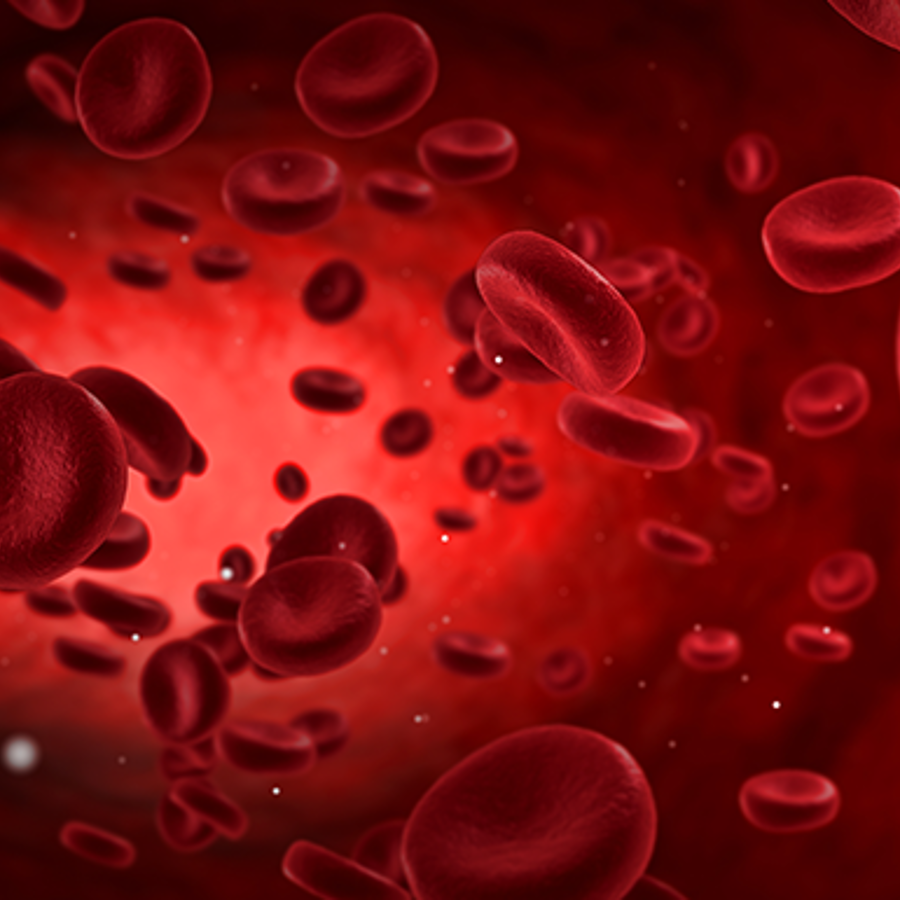
How does cis-AB blood type work?
June 4, 2018

- Related Topics:
- Common questions,
- Blood type,
- Rare events,
- Cis AB blood type,
- ABO blood type
A curious adult from the US asks:
"How does cis-AB blood type work?"
Blood type is one of the key examples of genetic inheritance that we learn about in school. And in the vast majority of cases, blood type follows predictable rules of inheritance.
But as with all rules, there are sometimes exceptions! Cis-AB is one of them.
This rare blood type makes it possible for an AB parent to have an O child. It also makes it possible for an O parent + AB parent to have AB children. Neither one of these outcomes is usually possible!
We normally talk about three different versions (or “alleles”) of the blood type gene: A, B, and O. Every person has two copies of their blood type gene: one from mom and one from dad. Usually, the only way to have type AB blood is to have one copy of the A version and one copy of the B version.
Cis-AB is a rare fourth version of the blood type gene. It is an allele that gives you type AB blood all by itself! If you have the cis-AB allele, the other allele you got from your parents will not affect your blood type. No matter what it is, you will have type AB blood.
Why is this? The cis-AB allele acts a little bit like the A version of the blood type gene and a little bit like the B version of the gene. So, it is one copy of a gene that does the job of two different versions of that gene. Usually the different versions of a gene are on different alleles. But in this case, it is like the A and B versions are right next to each other on the same allele!
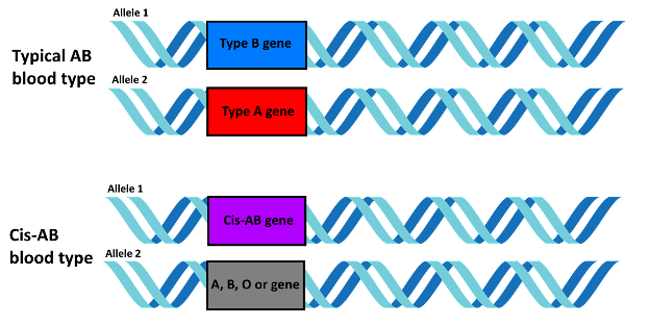
This is why we call it “cis”-AB. In genetics, “cis” means two things are happening on the same allele. AB blood type is usually a result of getting the A blood type gene from one parent and the B blood type gene from the other parent. But cis-AB is a result of getting a single allele that gives you both blood types all on its own.
It is worth noting that the cis-AB allele is very rare. While it has been observed worldwide, it is most prevalent in Korean and Japanese populations. Even then, it reaches a frequency of only 0.035% in Korea and 0.0012% in Japan.
Seoul has a population of 10 million people. We would expect only 3,500 people in Seoul will have the cis-AB allele. If you packed them all together in one spot, you could fit them comfortably into a typical convention hall. Tokyo has a population of 9 million people. Only about 100 people in Tokyo will have the cis-AB allele. You could probably fit all of them into a large coffee shop.
Inheriting cis-AB
The cis-AB allele can lead to some unusual patterns of inheritance for blood type. Let’s take a closer look at the genetics of the cis-AB allele to see how that happens.
The allele for type O blood is recessive. This means that if you have type O blood, both of your copies of the gene must be the type O version. You got one each from mom and from dad.
The A and B blood types are both dominant to the O blood type. This means the A and B versions of the genes take control in determining your blood type. If you get one copy of the A allele and your other copy of the gene is the type O version, you will have type A blood. The same thing goes for the B allele.
When paired with each other, the A and B blood type genes each affect your blood type equally. If you have one copy of the A allele and one copy of the B allele, you will have type AB blood.
In the chart below, I’ve shown all of these combinations. I’ve placed the genotype (a person’s combination of alleles) in the top left of each box, while blood type is written in the center.
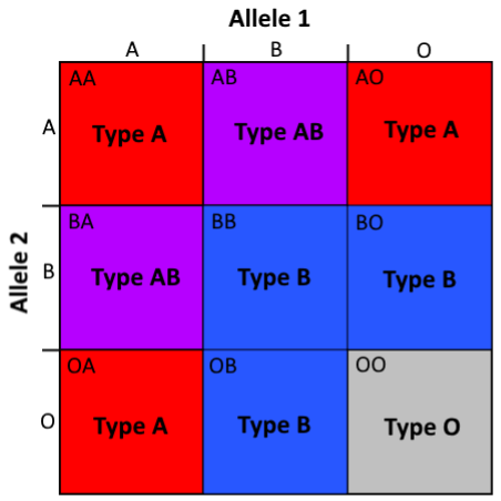
Now let’s add the cis-AB allele into the mix.
For the purposes of what you would see in a blood test, cis-AB is dominant to the other three alleles. If one of your copies of the blood type gene is cis-AB, your second copy can be the A version, B version, or O version, and you will still have type AB blood.
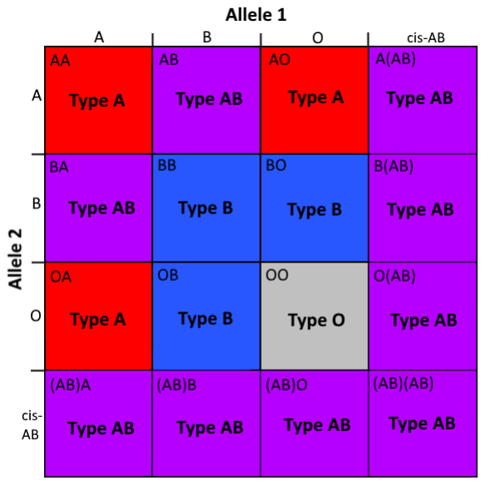
So imagine we have two people with type AB blood. One has it in the typical way: a copy of each of the A and B alleles. The other has it from a cis-AB allele. Is there any difference between these two people?
In terms of their blood type and ability to donate or receive blood, there is no difference. However, there is a significant difference in what the blood types of their children might look like.
Breaking inheritance rules
Let’s imagine two parents: one with type AB blood and one with type O blood. Under normal inheritance patterns, they will have either type A or type B children.
This is because the person with type AB blood will have one A allele and one B allele. They will give either allele to their children, who will receive a copy of the O blood type gene from the second parent.
But if the first parent has the cis-AB allele paired with an O allele, this changes. This couple would have either type AB or type O children.
Neither of these outcomes were possible under the normal patterns of inheritance!
Did you learn about Punnett squares in school? Geneticists use these to show what possible blood types any pair of parents might give to their children. Below, I’ve shown the Punnett squares for the sets of parents I just mentioned.
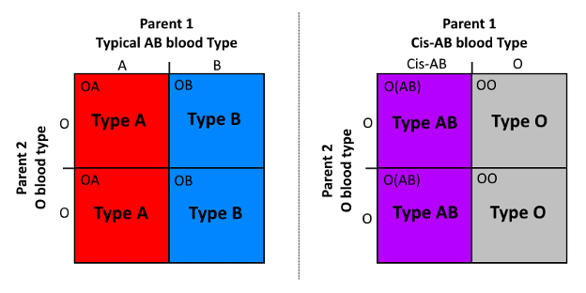
Cis-AB can also make it possible for a parent with Type A blood and a parent with Type AB blood to have a child with Type O blood. To see how, let’s make another Punnett square. This time, one parent has an A allele and an O allele. The other parent has the cis-AB allele and an O allele. A quarter of the time, their child will inherit both O alleles and have type O blood. The same result can occur when one Parent has type B blood and the other has type AB blood with the cis-AB allele.
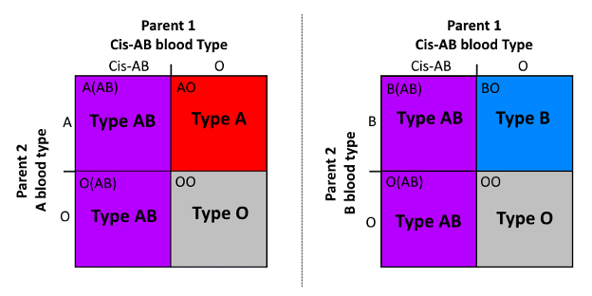
The genetics of blood type are more complicated than what we were taught in school. Cis-AB isn’t the only atypical way to get AB blood -- this is also possible with blood chimeras. And O blood type can also show up when we don’t expect it if one parent has the Bombay blood group.

Author: Robert Coukos
When this answer was published in 2018, Robert was a Ph.D. candidate in the Department of Genetics, studying protein engineering and directed evolution in Alice Ting’s laboratory. He wrote this answer while participating in the Stanford at The Tech program.
 Skip Navigation
Skip Navigation
